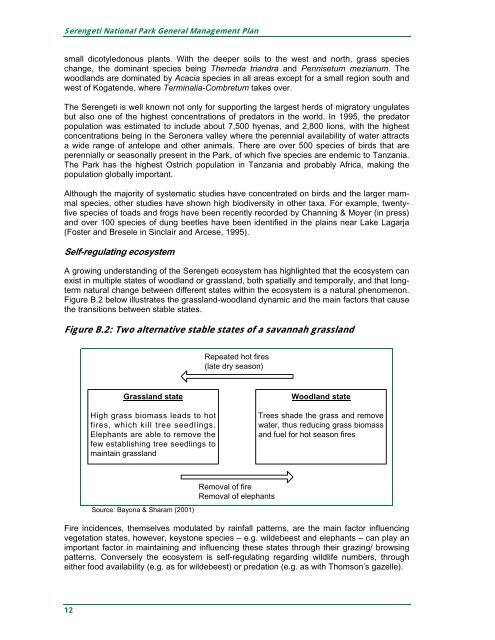Serengeti General Management Plan
Serengeti General Management Plan
Serengeti General Management Plan
- TAGS
- serengeti
- www.zgf.de
Create successful ePaper yourself
Turn your PDF publications into a flip-book with our unique Google optimized e-Paper software.
<strong>Serengeti</strong> National Park <strong>General</strong> <strong>Management</strong> <strong>Plan</strong><br />
small dicotyledonous plants. With the deeper soils to the west and north, grass species<br />
change, the dominant species being Themeda triandra and Pennisetum mezianum. The<br />
woodlands are dominated by Acacia species in all areas except for a small region south and<br />
west of Kogatende, where Terminalia-Combretum takes over.<br />
The <strong>Serengeti</strong> is well known not only for supporting the largest herds of migratory ungulates<br />
but also one of the highest concentrations of predators in the world. In 1995, the predator<br />
population was estimated to include about 7,500 hyenas, and 2,800 lions, with the highest<br />
concentrations being in the Seronera valley where the perennial availability of water attracts<br />
a wide range of antelope and other animals. There are over 500 species of birds that are<br />
perennially or seasonally present in the Park, of which five species are endemic to Tanzania.<br />
The Park has the highest Ostrich population in Tanzania and probably Africa, making the<br />
population globally important.<br />
Although the majority of systematic studies have concentrated on birds and the larger mammal<br />
species, other studies have shown high biodiversity in other taxa. For example, twentyfive<br />
species of toads and frogs have been recently recorded by Channing & Moyer (in press)<br />
and over 100 species of dung beetles have been identified in the plains near Lake Lagarja<br />
(Foster and Bresele in Sinclair and Arcese, 1995).<br />
Self-regulating ecosystem<br />
A growing understanding of the <strong>Serengeti</strong> ecosystem has highlighted that the ecosystem can<br />
exist in multiple states of woodland or grassland, both spatially and temporally, and that longterm<br />
natural change between different states within the ecosystem is a natural phenomenon.<br />
Figure B.2 below illustrates the grassland-woodland dynamic and the main factors that cause<br />
the transitions between stable states.<br />
Figure B.2: Two alternative stable states of a savannah grassland<br />
12<br />
Grassland state<br />
High grass biomass leads to hot<br />
fires, which kill tree seedlings.<br />
Elephants are able to remove the<br />
few establishing tree seedlings to<br />
maintain grassland<br />
Source: Bayona & Sharam (2001)<br />
Repeated hot fires<br />
(late dry season)<br />
Removal of fire<br />
Removal of elephants<br />
Woodland state<br />
Trees shade the grass and remove<br />
water, thus reducing grass biomass<br />
and fuel for hot season fires<br />
Fire incidences, themselves modulated by rainfall patterns, are the main factor influencing<br />
vegetation states, however, keystone species – e.g. wildebeest and elephants – can play an<br />
important factor in maintaining and influencing these states through their grazing/ browsing<br />
patterns. Conversely the ecosystem is self-regulating regarding wildlife numbers, through<br />
either food availability (e.g. as for wildebeest) or predation (e.g. as with Thomson’s gazelle).
















